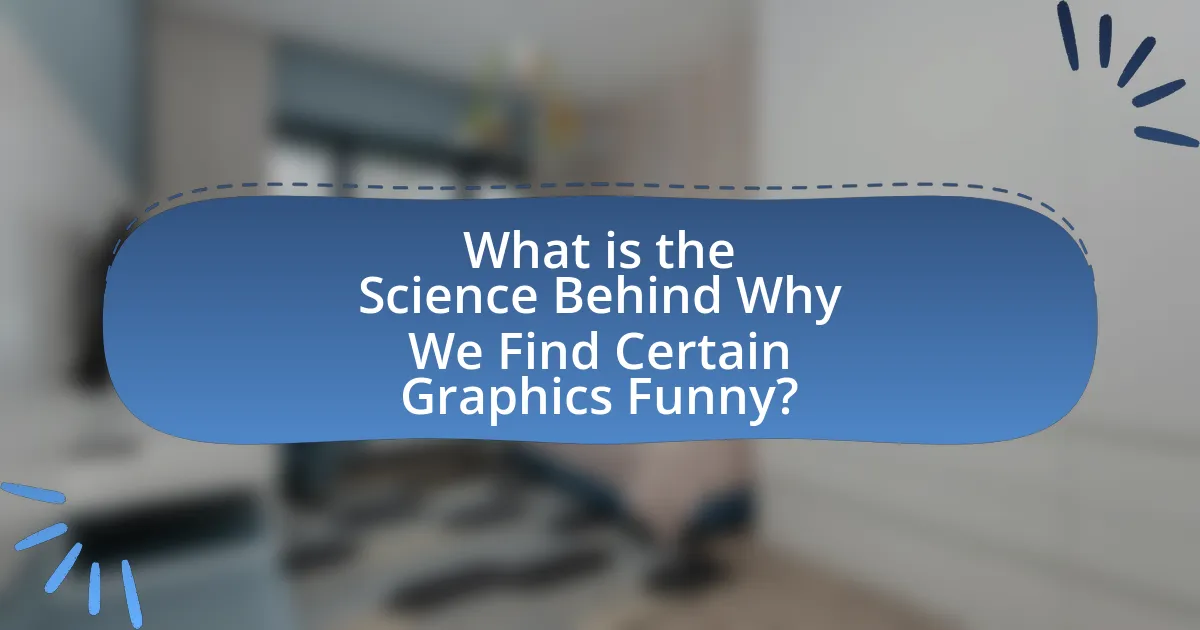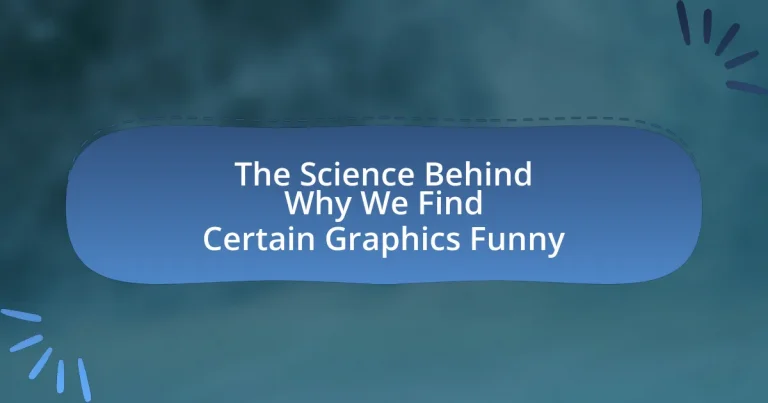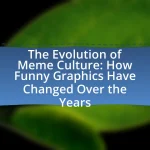The article explores the science behind why certain graphics elicit humor, focusing on theories such as incongruity theory and benign violation theory. It examines how humor in graphics enhances emotional responses and cognitive processing, engaging viewers and improving message retention. The article also discusses the psychological theories that explain our reactions to funny graphics, the influence of context and cultural factors, and the neurological responses involved in processing humor. Additionally, it highlights techniques for creating effective humorous graphics and analyzes the role of visual elements like colors, shapes, and exaggeration in eliciting laughter.

What is the Science Behind Why We Find Certain Graphics Funny?
Humor in graphics often arises from the incongruity theory, which posits that we find things funny when there is a mismatch between expectations and reality. This theory suggests that when a graphic presents an unexpected twist or absurdity, it triggers cognitive dissonance, leading to amusement. Research by psychologists such as Thomas Veatch indicates that humor is a cognitive process where the brain resolves this dissonance, often resulting in laughter. Additionally, the benign violation theory, proposed by Peter McGraw, states that humor occurs when something is perceived as a violation (e.g., a social norm) but is also seen as non-threatening. This interplay of cognitive processing and emotional response explains why certain graphics elicit laughter, as they often combine surprise with a safe context.
How do humor and graphics intersect in our perception?
Humor and graphics intersect in our perception by enhancing the emotional response and cognitive processing of visual stimuli. When graphics incorporate humor, they engage viewers more effectively, leading to increased attention and retention of the message. Research indicates that humorous visuals activate brain regions associated with pleasure and reward, such as the ventromedial prefrontal cortex, which enhances the overall enjoyment and memorability of the content. Additionally, studies show that humor can serve as a cognitive tool, facilitating the understanding of complex ideas by presenting them in a more relatable and entertaining manner, thus bridging the gap between information and engagement.
What psychological theories explain our response to funny graphics?
Psychological theories that explain our response to funny graphics include the Incongruity Theory, the Superiority Theory, and the Relief Theory. The Incongruity Theory posits that humor arises when there is a discrepancy between what is expected and what actually occurs, leading to a cognitive shift that elicits laughter. For example, a funny graphic may present an unexpected twist or absurdity that surprises the viewer. The Superiority Theory suggests that humor comes from the feeling of superiority over others, often seen in graphics that depict social faux pas or failures. Lastly, the Relief Theory indicates that humor serves as a release of psychological tension, where funny graphics can provide a momentary escape from stress or anxiety. These theories collectively illustrate the cognitive and emotional processes involved in our appreciation of humor in visual formats.
How does context influence our interpretation of humor in graphics?
Context significantly influences our interpretation of humor in graphics by shaping the viewer’s understanding and emotional response. The surrounding cultural, social, and situational factors determine how humor is perceived; for instance, a graphic that plays on current events may resonate more with audiences familiar with those events, while it may fall flat for others. Research indicates that humor often relies on shared knowledge and experiences, meaning that graphics that align with the viewer’s context—such as societal norms or personal experiences—are more likely to elicit laughter. This is supported by studies in psychology that show humor appreciation is linked to cognitive processing, where context helps in recognizing incongruities that are essential for humor.
Why do certain graphic elements elicit laughter?
Certain graphic elements elicit laughter due to their ability to create incongruity, surprise, and exaggeration, which are key components of humor. Incongruity arises when there is a mismatch between expectations and reality, prompting a cognitive shift that can lead to amusement. For example, a cartoon depicting a serious situation in a humorous light can trigger laughter by contrasting the expected seriousness with a playful representation. Additionally, surprise elements, such as unexpected twists or absurd scenarios, can enhance the comedic effect. Research by Richard Wiseman in “The Ascent of Humor” indicates that humor often relies on the brain’s processing of unexpected information, reinforcing the idea that graphic elements that disrupt normal patterns can provoke laughter.
What role do colors and shapes play in humorous graphics?
Colors and shapes significantly influence the perception of humor in graphics by evoking emotional responses and enhancing visual appeal. Bright colors, such as yellow and orange, are often associated with happiness and can amplify the comedic effect, while exaggerated shapes, like oversized heads or distorted bodies, create a sense of absurdity that contributes to humor. Research indicates that visual elements that deviate from the norm, such as unexpected color combinations or unusual shapes, trigger cognitive dissonance, leading to laughter as a response to the incongruity. This relationship between colors, shapes, and humor is supported by studies in psychology that demonstrate how visual stimuli can elicit emotional reactions, reinforcing the idea that effective humorous graphics rely on these elements to engage viewers.
How does exaggeration contribute to the funniness of graphics?
Exaggeration enhances the funniness of graphics by amplifying characteristics that evoke humor, such as absurdity or incongruity. This technique creates a stark contrast between reality and the depicted scenario, making the graphic more engaging and memorable. For instance, exaggerated facial expressions or oversized objects can trigger laughter by highlighting the ridiculousness of a situation, as supported by the incongruity theory of humor, which posits that humor arises when there is a deviation from expected norms. Studies have shown that visuals that incorporate exaggeration are more likely to elicit positive emotional responses, reinforcing the idea that exaggeration is a key element in the comedic effectiveness of graphics.
What are the neurological responses to funny graphics?
Neurological responses to funny graphics primarily involve activation in the brain’s reward system, particularly the ventral striatum and prefrontal cortex. When individuals view humorous graphics, these areas release dopamine, a neurotransmitter associated with pleasure and reward. Research indicates that the processing of humor engages the right hemisphere of the brain, which is crucial for understanding incongruities and context, leading to laughter and enjoyment. A study published in the journal “Neuropsychologia” by Mobbs et al. (2003) demonstrated that humor activates specific brain regions, confirming that the perception of funny images elicits measurable neurological responses linked to emotional and cognitive processing.
How does the brain process humor in visual stimuli?
The brain processes humor in visual stimuli primarily through the activation of specific neural pathways associated with cognitive and emotional responses. When an individual views a humorous image, areas such as the prefrontal cortex, which is involved in decision-making and social behavior, and the temporal lobes, which process visual information and recognize patterns, become engaged. Research indicates that the incongruity theory of humor plays a significant role; the brain detects a mismatch between expectations and reality, leading to a cognitive shift that elicits laughter. For example, a study published in the journal “Neuropsychologia” by researchers at the University of California found that humorous images activate the brain’s reward system, particularly the ventral striatum, reinforcing the pleasurable experience of humor.
What areas of the brain are activated when we find graphics funny?
The areas of the brain activated when we find graphics funny include the prefrontal cortex, the temporal lobes, and the limbic system. The prefrontal cortex is involved in cognitive processing and decision-making, which helps us understand humor. The temporal lobes, particularly the right side, play a role in processing visual information and recognizing patterns, essential for interpreting funny graphics. The limbic system, which includes structures like the amygdala, is associated with emotional responses, contributing to the enjoyment of humor. Research has shown that these brain regions work together to process humor, as evidenced by neuroimaging studies that highlight increased activity in these areas during humorous stimuli.
How do cultural factors influence our perception of funny graphics?
Cultural factors significantly influence our perception of funny graphics by shaping humor norms, values, and references. Different cultures have unique comedic styles, which affect what is considered humorous; for instance, Western cultures often favor irony and sarcasm, while Eastern cultures may emphasize situational humor and wordplay. Research indicates that humor is context-dependent, with a study by Martin et al. (2003) showing that cultural background impacts humor appreciation, as individuals are more likely to find graphics funny if they resonate with their cultural experiences and social norms. Thus, cultural context plays a crucial role in determining the effectiveness and reception of humorous graphics.
What cultural references are commonly used in humorous graphics?
Humorous graphics commonly utilize cultural references such as popular movies, television shows, memes, and iconic figures. These references resonate with audiences due to shared cultural knowledge, making the humor more relatable and impactful. For instance, graphics that parody well-known scenes from films like “Star Wars” or “The Office” leverage familiarity to elicit laughter. Additionally, internet memes, which often reference current events or viral trends, create a sense of community among viewers who understand the context. This reliance on cultural touchstones enhances the effectiveness of humor in graphics by tapping into collective experiences and societal norms.
How does cultural background affect humor appreciation in graphics?
Cultural background significantly influences humor appreciation in graphics by shaping individuals’ values, beliefs, and social norms. For instance, humor that relies on cultural references, language nuances, or societal taboos may resonate differently across diverse cultural groups. Research indicates that humor often reflects the shared experiences and contexts of a particular culture, making it more relatable to individuals within that group. A study by Martin et al. (2003) found that humor appreciation varies across cultures, with Western cultures often favoring individualistic humor, while collectivist cultures may prefer humor that emphasizes group harmony. This cultural lens affects how graphics are interpreted, leading to variations in what is considered funny.
What are the common types of funny graphics?
Common types of funny graphics include memes, cartoons, infographics, and humorous illustrations. Memes often combine images with witty text to create relatable humor, while cartoons use exaggerated characters and situations to elicit laughter. Infographics can present data in a humorous way, making complex information entertaining. Humorous illustrations often depict absurd scenarios or play on visual puns, engaging viewers through visual wit. These types of graphics leverage humor principles such as incongruity and surprise, which are essential in eliciting laughter.
What distinguishes memes from other humorous graphic formats?
Memes are distinguished from other humorous graphic formats by their unique combination of relatability, cultural context, and rapid dissemination through social media. Unlike traditional cartoons or jokes, memes often leverage shared experiences or current events, making them more relevant and engaging to specific audiences. For example, the “Distracted Boyfriend” meme effectively captures a relatable scenario that resonates with many, illustrating how memes can encapsulate complex emotions or situations in a single image. This relatability, combined with the ability to remix and adapt memes quickly, allows them to spread virally, reinforcing their impact and humor in a way that other formats typically do not achieve.
How do cartoons and illustrations differ in their approach to humor?
Cartoons and illustrations differ in their approach to humor primarily through their use of exaggeration and context. Cartoons often employ exaggerated features, absurd scenarios, and caricatures to create humor, making the absurdity of the situation more pronounced. For example, political cartoons utilize satire to comment on current events, using hyperbole to emphasize the ridiculousness of political figures or situations. In contrast, illustrations may rely on subtlety and visual storytelling, where humor is derived from the context or the interplay of characters within a scene, often requiring the viewer to infer the humor rather than having it overtly presented. This distinction highlights how cartoons prioritize immediate visual impact and exaggeration, while illustrations may focus on narrative and context to evoke humor.
How can understanding the science of funny graphics enhance creativity?
Understanding the science of funny graphics can enhance creativity by providing insights into humor mechanisms that stimulate innovative thinking. Research indicates that humor activates the brain’s reward system, promoting dopamine release, which is linked to creative problem-solving. For instance, a study by Andrew F. Bennett and colleagues published in the journal “Cognitive Science” found that humorous stimuli can lead to increased cognitive flexibility, allowing individuals to make novel connections between seemingly unrelated concepts. This cognitive flexibility is essential for creative processes, as it encourages divergent thinking and the exploration of unconventional ideas. Thus, grasping the principles behind what makes graphics funny can serve as a tool for fostering a more creative mindset.
What techniques can be used to create more effective humorous graphics?
To create more effective humorous graphics, techniques such as exaggeration, incongruity, and visual puns can be employed. Exaggeration amplifies characteristics or situations to an absurd level, making them more amusing; for instance, depicting a character with oversized features can enhance comedic effect. Incongruity involves presenting unexpected elements that clash with the viewer’s expectations, which can trigger laughter; an example is placing a serious character in a silly context. Visual puns play on words through imagery, creating a dual meaning that can elicit humor; for example, illustrating a “couch potato” as a literal potato sitting on a couch combines visual and verbal humor. These techniques are supported by psychological theories of humor, such as the incongruity theory, which suggests that humor arises when there is a discrepancy between what is expected and what occurs.
How can one analyze existing funny graphics for inspiration?
To analyze existing funny graphics for inspiration, one should examine the elements that contribute to humor, such as visual puns, exaggeration, and relatable scenarios. By identifying these components, individuals can understand how they evoke laughter and apply similar techniques in their own creations. Research indicates that humor often arises from incongruity and surprise, which can be observed in successful funny graphics. For instance, a study by Martin (2007) in “The Psychology of Humor: An Integrative Approach” highlights that unexpected twists in visuals can enhance comedic effect. Analyzing these aspects allows creators to draw inspiration and innovate within the genre of humorous graphics.
What practical tips can help in creating funny graphics?
To create funny graphics, focus on using relatable humor, visual puns, and unexpected juxtapositions. Relatable humor connects with the audience’s experiences, making them more likely to find the graphic amusing. Visual puns play on words and images, creating a clever twist that engages viewers. Unexpected juxtapositions, where contrasting elements are combined, can evoke surprise and laughter. Research indicates that humor often arises from incongruity, where the unexpected leads to amusement. For instance, a study published in the journal “Cognitive Science” by researchers such as Martin and Ford highlights that humor is frequently derived from the resolution of incongruity, reinforcing the effectiveness of these techniques in graphic design.


